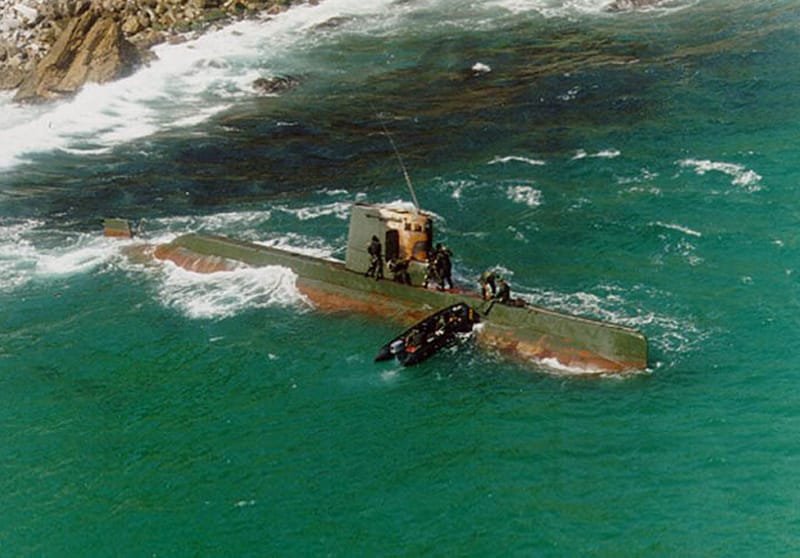North Korean Submarines Must Be Considered A Threat To The U.S. and the sinking of the South Korean Ship
The navy of North Korea was established on June 5, 1946. The Navy strength in the 1990s was about 40,000 to 60,000; current strength is about 46,000. There are some 708 vessels including 3 frigates and 70 submarines: approximately 20 Romeo class submarines(1,800 tons), 40 Sang-O class submarines (300 tons) and 10 midget submarines including the Yono class submarine (130 tons). Numbers of subs listed are from the Defense Intelligence Agency. Most N. Korea vessels are small patrol – size craft unable to operate over 50 nautical miles from the coast but capable of policing the N. Korean territorial waters. The most capable weapons systems are the approximately 43 guided-missile patrol boats equipped with anti-ship missiles. The N. Korean Navy has OSA-1 guided missile patrol boats, 10 versions of the OSA-1, and 19 other fast-attack missile craft; all equipped with four missile launchers. The missiles have a maximum range of 25 nm and carry radar or infrared homing seekers. The largest part of the NKN consist of small combatants, including torpedo boats, patrol boats, fast attack craft, and small amphibious landing craft. Of the approximately 200 torpedo boats, nearly all are built in N. Korea. Most all are equipped 25mm to 37mm guns. There are at least 62 fire support units. These vessels have multiple rocket launchers in the center of its deck to provide fire support to ground troops or attack surface ships. Their attack submarine inventory is estimated to include 4 former Soviet WHISKEY class, 22 Chinese ROMEO Class submarines. The WHISKEY subs were acquired in the 1960s, and can carry 12 torpedoes or 24 mines. Shortly after delivering four ROMEOs in the early 1970s, China helped the NKN start its own ROMEO construction program. These subs are well equipped with improved sonar, and can carry 14 torpedoes or 28 mines. To date, the NKN has indigenously produced over 200 landing craft. This includes approximately 100 personnel landing craft based on a former Soviet P-6 torpedo boat hull. The craft has a maximum speed of 40 knots, each carrying up to 30 troops with a basic combat load. Amphibious craft include 8 medium landing ships, which can carry 3 to 4 light tanks, and 125 amphibious hovercraft. The NKN has a credible mine warfare capability. There are numerous small surface ships that are capable of delivering mines within both the Navy and civilian sectors. Mines will be used to defend against amphibious assaults, defend strategic ports, and provide seaward flank protection for land forces. Defensive mine fields will be monitored by coastal observation teams and radar. They will be supported by artillery and missile batteries. This will make close approach and mine clearing operations extremely hazardous. The NKN has a large inventory of older technology mines, experience with their effectiveness, and the willingness to use them.
Be advised that any and all reports concerning information on the N. Korean Navy is only approximate. Any information on the N. Korean military, especially the Navy, is the most secretive of any country in the world. Military equipment in large amounts is available from Russia and China. Spare parts and technological help are available, with China even supervising the construction of a plant for N. Korea to manufacture their own submarines. After observing many lists of names and numbers of submarines, how many in service, modifications, location, etc. it was obvious of the difference in reports. The following reports are as accurate as possible and may differ with numerous other reports. Remember that some subs built by N. Korea may use Russian technology which is based on German submarines from 1945. Also, parts including complete submarines are available from China and Russia.
An incident between a Chinese submarine and the U.S. Navy has caused the U.S. to take another look at our capability using old technology. A state-of-the-art Chinese Song Class submarine sailed within torpedo range of the U.S. Super Carrier USS KITTY HAWK during U.S. Naval exercises off the Chinese coast. U.S. Navy brass was completely outsmarted by the incident. The USS KITTY HAWK, 1,000 Ft. Super Carrier carried 4,500 personnel. The U.S. had no idea China’s fast growing submarine fleet had reached such a level of sophistication, or that it posed such a threat. Our defensive screen, which included two U.S. submarines, was apparently unable to detect it. The Chinese submarine slipped past at least a dozen U.S. warships which were supposed to protect the carrier from hostile aircraft and submarines. The Chinese fleet includes at least two nuclear-missile launching vessels. The 13 Song class submarines are extremely quiet and difficult to detect when running on electric motors.
Two ships are examples of the growing Chinese threat are the Chinese T-Class ship, and the Ming Class submarine. There are no reliable figures on these two vessels, and we do not really know how many remain in service, or how many have been transferred to N. Korea. Both can cause us big problems, especially with the addition of nuclear missile launchers.
N. Korea is controlled by a hereditary dictatorship, ineptly run by Kim Jong-il. N. Korea is an impoverished country needing international aid to keep it’s population from starving. Their situation is dire, as virtually every cent they have is spent on military equipment in hopes of causing WWIII. This article covers only the N. Korean Navy capability, and inventory. After the unnecessary Korean war of 1950, the country was completely destroyed by our constant aerial bombardment. N. Korea’s arrogance has increased significantly since they won the war. Actually, the 200,000 Chinese troops and swarms of Russian Mig-15s assured their victory. That was 60 years ago, and since then nothing has changed except their country has continued to deteriorate. Where this will end up will be determined by Kim Jong-il, who is not only physically sick, but very short on intelligence.
In reading this report there are two things you will notice: N. Korea seems to have a formidable Navy not to be taken lightly. However another look exposes the fact that everything they have is really aging and outdated. We must remember that a shot fired by a Civil War gun will kill you as quickly as one fired from one of today’s weapons.
Korean People’s Navy Inventory
Warning
It may be well to consider that other countries may be catching up with us, along with using different attack techniques. Chinese and N. Korean plans are to immediately destroy our carriers with a swarm of missile boats and submarines, along with the reported Russian development of “one bomb one carrier”. The main problem as I see it is the lack of a “will to win” on our part. We lost the war in Korea in 1950 along with 36,913 men. We accomplished nothing in that war, ending up where it began. Vietnam was another large catastrophe that was an embarrassment for the U.S. costing us 58,202 men. We fabricated a reason to get into the war with Iraq, and the so called war in Afghanistan that has been going on longer than WWII. Lurking in the future are major confrontations with N. Korea again, and Iran. God forbid a disagreement with China. How many wars can the U.S. handle at a time when we are not only short on equipment, but personnel.
The Chinese Submarine Incident
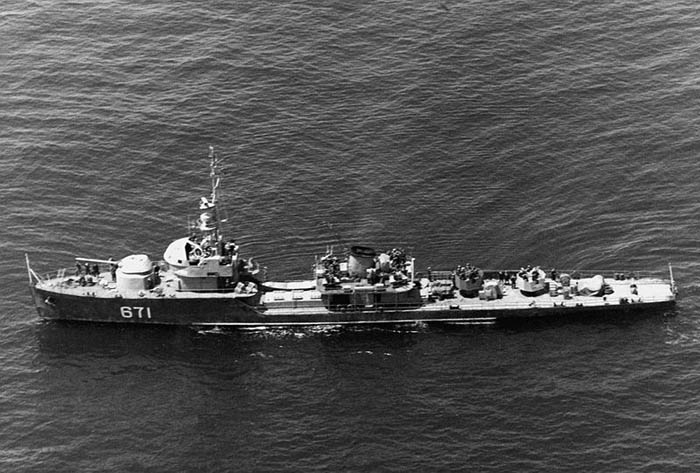
N. KOREAN NAVY T-CLASS
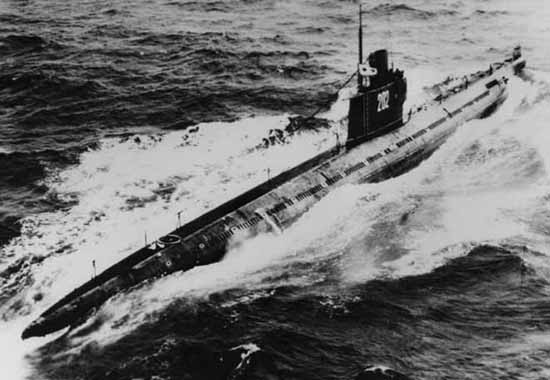
| ROMEO CLASS SUBMARINE | |
| Displacement: | 1,830 tons |
| Length: | 251 ft 3 in. |
| Propulsion: | Two diesels delivering 4,000 shaft horsepower with two electric motors driving two shafts. |
| Speed: | 15.2 knots surfaced, 13 knots submerged. |
| Range: | 9,000 miles at 9 knots. |
| Crew: | 54 men ( 10 officers). |
| Armament: | Eight 21 in. torpedo tubes. Six located in the bow and two in the stern. 14 (21 in.) anti ship or anti submarine torpedoes or 28 mines. |
North Korea operates 22 Romeo class submarines that were locally made with Chinese supplied parts and directly imported from China. The 4 Chinese imported units are based on the western front. It may be well to mention the fact that all of the figures of N. Koreas submarines continue to change as they now have their own construction capability, and can receive parts from China thus prolonging the life of existing submarines.

Whiskey Twin Cylinder Submarine
In the 1950s and 1960s some Whiskey submarines were converted to guided missile boats. These boats had the capability to fire one to four cruise missiles. In 1956 the first prototype was ready. It was a regular Whiskey-class submarine which was fitted with a launch tube aft that contained a single anti-ship missile. This vessel was known in the west as a Whiskey Single Cylinder. Between 1958 and 1960, six additional Whiskey-class submarines were converted to carry guided missiles. These boats had two missile tubes and were known as the Whiskey Twin Cylinder. Between 1960 and 1963, six boats received modifications that could contain four missiles. All guided missile variants had to surface to fire their missiles. The patrol variants were replaced by Romeo-class submarines. The guided missile variants were replaced by Juliet-class submarines.
| WHISKEY TWIN CYLINDER SUBMARINE | |
| Displacement: | About 1,350 tons. |
| Length: | 249 ft 4 in. |
| Propulsion: | Diesel-electric |
| Speed: | 18.5 knots surfaced. |
| Range: | 13,500 nmi surfaced |
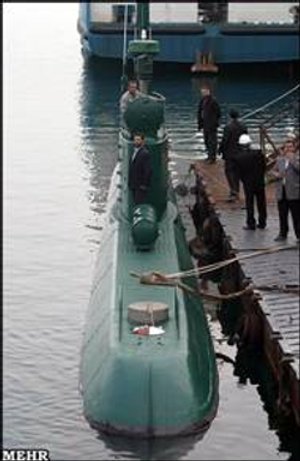
YONO CLASS MIDGET SUB wiki
The Yono class submarine is a class of N. Korean miniature submarines, produced for domestic use and export. These submarines displace 130 tons, significantly less than N. Korea’s larger 1,800-ton Romeo class submarine. As of May 2010, N. Korea is reported to operate 10 of these submarines. Iran has purchased several of these submarines from N. Korea
| SANG-O CLASS N. KOREAN SUBMARINE | |
| Propulsion: | Diesel engine. |
| Armament: | two 21 in. torpedo tubes. |
A Yono class submarine is thought to have fired the torpedo which sank the South Korean Pohang-Class Corvette, the Cheonan, on March 26, 2010 in South Korean waters. The weapon used was a N. Korean manufactured CHT-02D torpedo, of which substantial parts were recovered. The device exploded not by contact, but by proximity, creating a powerful pillar of water called “the bubble jet effect”.
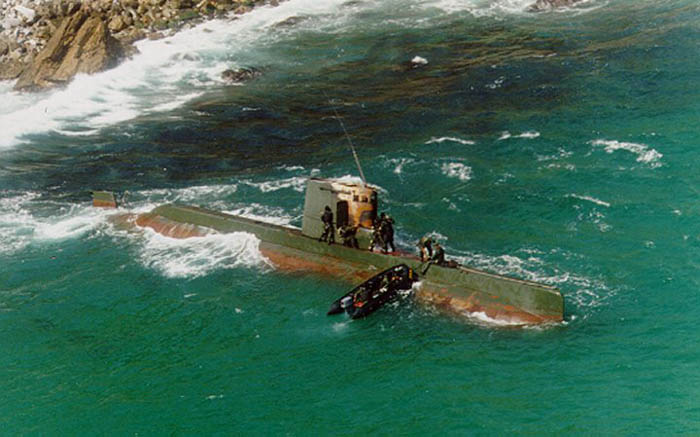
SANG-O CLASS N. KOREAN SUBMARINE
The SANG-O class submarines are currently in use by N. Korea, and are the country’s largest home built submarines. This class is based on the Yugoslavian Heroj class submarines. They have been stripped down and have vintage radar and sonar.
The SANG-O was preceded by the Yugo class. There are reportedly 32 boats active as of August 2006.
| SANG-O CLASS N. KOREAN SUBMARINE | |
| Displacement: | 370 tons |
| Length: | 34m |
| Propulsion: | Diesel-electric |
| Range: | 1,500 nautical miles |
| Crew: | 25 |
| Sensors: | Radar and Sonar |
| Armament: | two 21 inch torpedo tubes fitted with Russian torpedoes. Capable of minelaying. |
The KOMAR CLASS
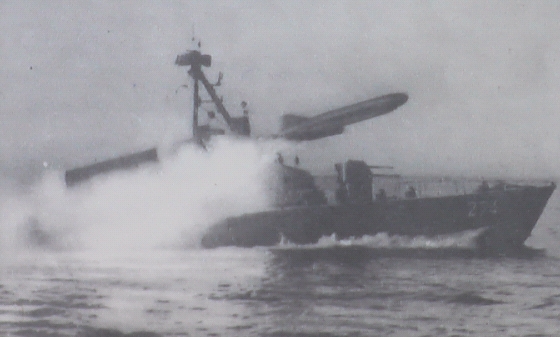
Komar Class Boat Launching a Missile Wiki
The KOMAR CLASS missile boats were built for the Soviet Navy. The Soviet designation was 183 R. Ten of these boats were transferred to the N. Korea Navy. The Komar was designed just after World War II. This boat was armed with two single 533 mm torpedo tubes and was extensively used by Soviet coastal forces in the 1950s. Over 622 MTBs were built. A sub-chaser variant was fitted with Sonar and depth charges was also built as was a radio controlled target boat. These vessels built so many years ago might seem to be of no use in today’s warfare, however new spare parts, upgrades and constant maintenance make them a useable weapon. In 1956, the SS-N-2 missile became available and the Soviets fitted it to the Project 183 hull, to produce the world’s first missile boat. A total of 112 Komars were built between 1956 and1965 and served in the Soviet Navy until the 1980s. It must be considered that these ships transferred to the N. Korean Navy have Chinese and Russian parts, maintenance help, and technology to keep these ships a direct threat. The Komar was succeeded the OSA class fast missile boat. The Komar displaced 66.5 tons full load, had a length of 25.4 m. Propulsion was by 4 shaft diesels of 4,800 hp. Speed was reported at 44 knots, with a range of 600 nm. It carried a crew of 11 machine guns plus the missiles. In 1967 October 21-a Komar -class missile boat sank Israeli destroyer EILAT in the first combat use of P-15 Termit surface to surface missiles.
The OSA Class
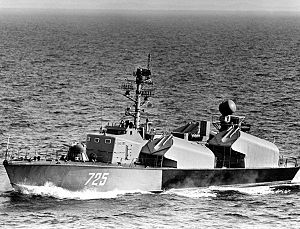
Osa-1 Class Missile Ship Wiki
The OSA Class is a fast attack craft developed for the Soviet Navy in the 1960s. These craft are probably the most numerous class of missile boats ever built, with over 400 vessels constructed for both the Soviets and for export to allied countries. Two main variants were built: the OSA 1 which had box-shaped missile containers and the OSA 2 which had cylindrical missile containers.
The OSA missile boats were designed to be a much better fighting vessel than the Previous Komar Class warship. The crew , numbering 11, was not large enough to employ all the systems. They were organized in squadrons of six units, because it was expected that every NATO destroyer needed two missile hits to be sunk, and this could be assured with 12 missiles. Three squadrons were used for every target to assure one was successful OSA ships were bigger than the KOMAR class, with a mass four times greater, and a crew of 30. The OSA could achieve high speeds as they had three diesel engines capable of 12,000 hp, and 15,000 hp on the OSA II. All engines were linked to one propeller. The powerful engines allowed a maximum speed of 40 knots.
The missile armament consisted of four hangars to protect them from bad weather. The missiles were controlled by a Garpun Radar, and ESM/ IFF Hig-Pole that allowed targeting even over the horizon, if the target emitted radar impulses. With all these improvements these ships were more effective. The survivability rate improved to 50%. The 12 missiles could be launched by only three ships. The sinking of a destroyer was assured using 12 missiles launched by only three ships, making the OSA vessels easier to coordinate and even cheaper than 18 Komars. As a result of these improvements, OSAs were without equal in the 1960s. Over 400 were made I the USSR, and another 120 in China.
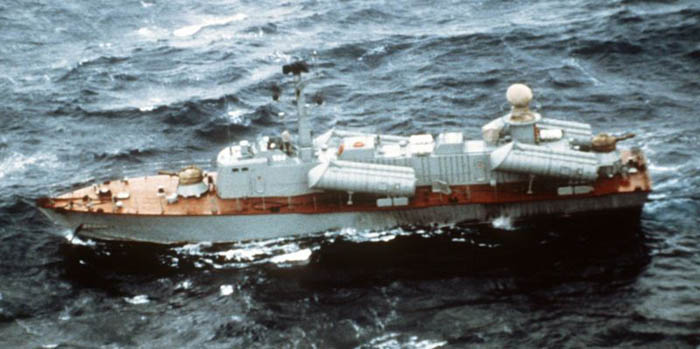
Osa Ii Class Missile Ship Wiki
The improved OSA II was equipped with surface to air missiles with two quad launchers and 16 missiles, which greatly improved air defense. The new OSAII had more powerful engines, and improved P-20M missiles. OSAs were used in the Iraq-Iran War, and suffered many losses by F-4s. The Iraq Navy also incurred heavy losses. At one time they were equipped with supersonic missiles. Few were built, however, and information is difficult to get concerning the number in service, if any, today.
| OSA II CLASS MISSILE SHIP | |
| Displacement: | 219 tons |
| Length: | 37.5 m |
| Propulsion: | three waterjets, 12,500 hp. |
| Speed: | 38 knots |
| Crew: | 26/28 |
N. Korea has an understandingly excellent relation with China. China is spending huge amounts on submarine technology. Not mentioned fully in this story are many Chinese developments in their subs. Their Song class sub was upgraded to the Yuan class which has a long list of significant improvements. The capability of this class of sub is indeed something to consider, since the U.S. continues to cut back spending on the military, with a diminishing number of actual combat troops. They are building 15 of these, and have already started construction on it’s upgrade. The problem here is once again, how many will end up in N. Korea, controlled by Kim Jong il who is demanding to start a war. Their continued advancement with the cruise type missile continues.
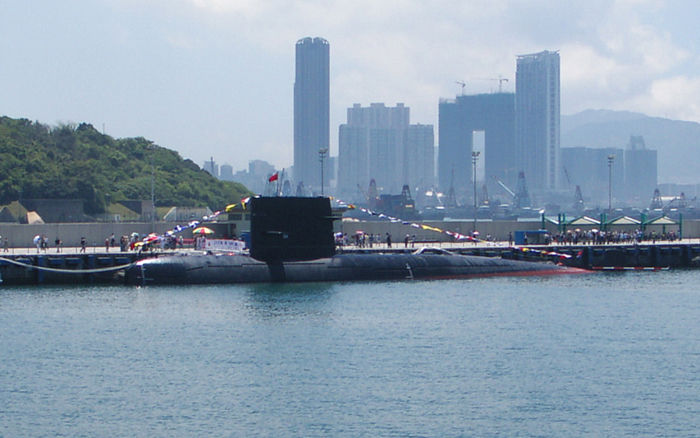
Song Class 039 Submarine
The first Chinese submarine was the locally produced derivative of the Romeo class provided to China by the Soviet Union. Large numbers were built but China developed a wholly new class on its own. Development was not without problems requiring lengthy testing periods. !0 were completed.
| SONG CLASS 039 SUBMARINE | |
| Displacement: | 2,250 tons. |
| Length: | 74.9 m |
| Propulsion: | Diesel electric, 1 shaft |
| Armament: | 6 Torpedo tubes, 18 torpedoes, or 36 naval mines. |
The main sensor sonar has passive and active modes, which is used for both search and attack. It has a torpedo approach warning system capable of tracking four targets. This class is the first Chinese submarine designed for electronic warfare, utilizing a radio direction finder/ radar warning receiver system, submarine radar recon. equipment with a 100% detection rate. The electronic system can be operated by a single operator or fully automatic. The combat data system can track multiple targets.

Type 041 Yuan Missile Ship
The Type 041 sub, preceded by the type 039 Song Class, has six torpedo tubes, capable of launching anti-ship missiles. The missile uses inertial terminal active radar guidance. It carries a time-delayed semi-armour-piercing high-explosive warhead, with a speed of 0.9. It is also capable of firing missiles under water. The 041 uses the super quiet pump-jet electric propulsion system. It also uses the air-independent -propulsion -system. The length is 75m. Propulsion uses diesel-electric, one shaft, air independent propulsion. It has a speed of over 20 knots. It is the newest class of diesel electric submarine. The improved “”A”” variant has been launched. China has a large amount of engineers working on a nuclear powered sub. It has been impossible to obtain any information at all concerning progress on this vessel. The purpose of covering Chinese submarines is the previously mentioned possibility of how many and when they will be made available to North Korea.
China has effective operating anti-satellite weapons. In addition to their ballistic missiles it is developing the ability to jam, blind, or otherwise disable U.S. satellites and their terrestrial infrastructure. China placed 15 satellites into orbit in 2008, including four new remote sensing satellites, a manned spacecraft and a companion satellite, three communications satellites, and two for meteorology. They also launched their first data relay satellite. Construction has begun for a new rocket facility which will place heavier payloads in space powered by the world’s largest rocket, the March V. Their first lunar probe continues to operate successfully, and will launch to survey the moon surface. I doubt very seriously if many Americans are aware of their military progress, as the U.S. does not make this information available.
Chinese Satellite Development

Ming Class Submarine
The Central Military ordered the building of the Ming Class submarine in 1967 as project 035. The construction of the first began in October 1969. The last boat was built in 2002. A total of 20 were built, of which 17 are still in service. The 13th boat was built in 1995, making it one of the newest in the fleet. Ming Class Characteristics
| SONG CLASS 039 SUBMARINE | |
| Displacement: | 2,113 tons. |
| Length: | 249 ft. 4in. |
| Propulsion: | 2 diesels rated at 5,200 hp with two shafts. |
| Speed: | 15 knots. |
| Armament: | 8 torpedo tubes. |
The North Korean Sinking of a South Korean Ship
This story was most difficult for me to write as there are so many ridiculous claims and counter-claims. You will find it impossible to believe that after having a ship sunk, with loss of life, SOUTH KOREA, of all people refused to acknowledge the obvious that N. Korea did it. On March 26, 2010, a very predictable occurrence took place. N. Korea sank a S. Korean ship. The S. Korean ship, the “”Cheonan”” was on a patrolling mission in disputed N. Korean waters. S. Korea had been warned several times that any future penetration in their territory would lead to military intervention. The Cheonan was sunk by a N. Korean torpedo. The ship exploded and sank immediately. 46 of the 104 man crew were unaccounted for. So far we have not gotten to the real story. SOUTH Korea claimed that N, Korea had nothing to do with the sinking, and that the Ship hit a rock in the middle of the ocean and exploded and sank. Another one of their ships fired at an apparent fleeing vessel but S. Korea said it was firing at a flock of birds. Actually the most preposterous story ever told. About 45 minutes after the sinking the White House was notified. Again it is no surprise that Press Secretary or the President even acknowledged it took place. The White House has a bad reputation of withholding information. This story is so pathetic that it really belongs in the funny papers, except it is not funny.

South Korean Warship 772 Sunk by N. Korea Wiki
Contradicting the explosion by a rock, an investigation report carried out by a team of international experts concluded surprisingly that it was actually a torpedo that did the sinking. The explosion occurred near the stern of the ship which caused it to break in half five minutes afterwards. After the explosion the captain contacted fleet headquarters to say: “”We are being attacked by the enemy.””
Recovery of the ship was started by using a giant crane, with the stern being raised first. The bodies of 40 personnel out of the 46 who went down with the ship were recovered. S. Korean officials again downplayed any suggestion that N. Korea was responsible in any way for the sinking. It gets worse! Defense Minister Kim Tae-Young stated that the explosion was caused by a N. Korean mine left over from the Korean War, 60 years ago. On March 30, 2010, Defense Minister spokesman Won Tae-jae dismissed any idea that a torpedo could have torpedoed the ship. A Pusan National University professor suggested the Cheonan ran into a rock in shallow water and exploded. S. Korean media said that the ship did not split in half from an explosion. So the senseless argument went on and on, with S. Korea refusing to put any blame on N. Korea. It was a month later on 25 April, 2010 that Defense Minister Kim said it was most likely a torpedo, not mentioning where it might have come from. So far we have heard nothing but claims from mentally deficient people. Next one takes the cake. Chinese officials claimed that the sinking of the Cheonan was caused by an AMERICAN RISING MINE which is moored to the seabed and propels itself into a ship it has detected with magnets. China further said that N. Korean subs were incapable of moving undetected within S. Korean waters, and the damage was obviously caused by the rising mine and not by a torpedo.
On May 18, 2010, the Washington Post reported that a team of investigators concluded that a N. Korean Torpedo sank the ship. They found traces of RDX, a high explosive more powerful than TNT and used in torpedoes. A serial number similar to those used by N. Korea was found. And now the denials continue. After a substantial amount of the torpedo was found, N. Korea said it would be impossible for so much of the torpedo to survive the explosion.

N. Korea Torpedo Evidence
The investigating team finally released their report, commenting that “”The evidence points overwhelmingly to the conclusion that the torpedo was fired by a N. Korean Submarine.”” The specific weapon used was a N. Korean manufactured CHT-02D torpedo. The parts recovered by the dredging ship included the 5×5 bladed contra- rotating propellers, the propulsion motor and a steering section, perfectly matching the schematics provided by N. Korea to foreign countries who purchased them. N. Korean Central News Agency complained again the charges were unbelievable.
Is that all now? Well not really. Even South Korea disputes the findings and do not believe N. Korea was involved. Even a spokesman for the S. Korean Military stated that there was no evidence that N. Korea was involved in any way in the incident. Then the heavy accusations that the entire episode was concocted by the U.S.
We finally get to the end. N. Korea now insist that their team of experts come and examine the torpedo. Kim Jong il continued his tirade that he was going to punish the U.S. with “”Massive Retaliation”” including the use of any and all Nuclear weapons it possesses. This article written on June 15, 2010.
- The Battle of Midway: Turning the Tide in the Pacific - June 7, 2023
- The D-Day Operation of June 6, 1944 - June 6, 2023
- The B-29 that Changed History - June 4, 2023

